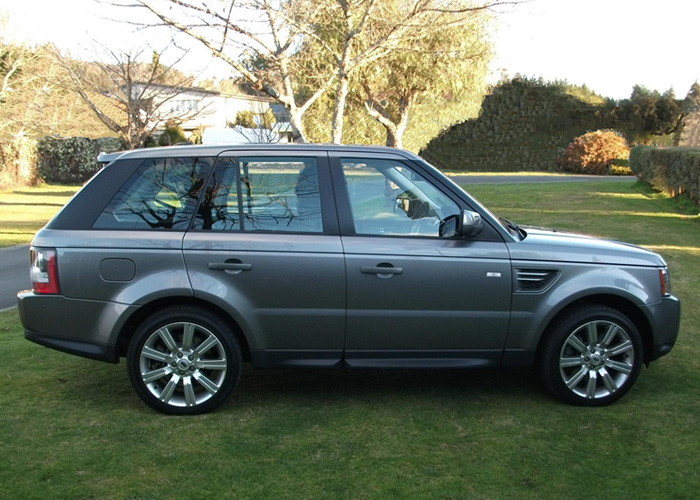
Car reviews
Read our expert car reviews - where we give insight into the latest vehicles to hit our roads.
09 February 2011
More than just a new face, the latest evolution of the 2010 Range Rover Sport offers all that and then some. The jewel in the crown is what’s under the bonnet.

New lights, new grille, new bumpers and new wheels are some of the features we’ve come to expect of a facelift model. The latest evolution of the Range Rover Sport offers all that and then some.
The new two bar grille, LED lights, revised bumpers and new 19 inch alloy wheels freshen up the look, as do mildly re-stamped sheet-metal and ever-so subtle tweaks to the side vents. But the biggest improvements to the new Range Rover Sport are even further refinements in the already luxurious cabin fit-out and significant powertrain upgrades.
The Sport was always intended to be an entry level Range Rover. While “entry level” and “Range Rover” mentioned in the same sentence might appear to be something of an oxymoron, being based on Land Rover Discovery underpinnings, the Range Rover Sport doesn’t compete head to head with its bigger sibling, the Range Rover Vogue but does offer Rangie opulence at a lower price point.
And opulent it is, with higher quality materials than before, improved cabin layout and more user-friendly switchgear the baby Range Rover is a class act.
Cabin pleasantries include a premium Harmon Kardon 14 speaker sound system, Sat Nav with a 7 inch high res touch screen, highly polished Anigre veneer timber finishes, double stitched soft leather, heated seats front and rear, keyless start, heated and acoustic windscreen and all the latest portable audio interfaces.
But the jewel in the crown is what’s under the bonnet. Our test vehicle, the new TDV6 was fitted with a 3.0 litre twin turbo TDV6 diesel engine that produces 180kW of power at 4,000rpm and 600Nm of torque at 2,000rpm.
Capable of hauling the 2.5 tonne Range Rover Sport to 100km/h in a respectable 9.3 seconds or lugging a 3,500kg tonne trailer about, it’s an impressive powerplant, offering decent fuel consumption of 9.1L/100km.
Like the 2.7 litre V6 diesel it replaces, the 3.0 TDV6, jointly developed with Peugeot/Citroen, is also used in the XF Jaguar. However, for Range Rover use, upgrades to the engine include a deeper, larger capacity sump with modified baffles to maintain oil pressure at steep angles and improved seals to keep out mud, grit and water in off-road situations.
Mated to a slick shifting six speed auto, the permanent 4WD driveline coupled with Electronic Air Suspension (EAS) provides highly capable on-road ability with outstanding comfort and confident handling on the tarmac.
While we didn’t go off-road, (and let’s face it, how many Range Rover drivers do?), the Range Rover Sport comes with all the trick off-road gadgets you’ll need if you do venture beyond Remuera or Fendalton.
With the simple push of a button and twist of a dial on the centre console, the Terrain Response system can be set to maximise off-road ability depending on the type of terrain encountered. Ride height and level, torque delivery, throttle response and traction systems are all electronically managed.
The Centre Electronic Differential, Low Range Transfer Box, Electronic Air Suspension, Hill Decent Control (HDC), Gradient Release Control (GRC) all play their part in optimising off road behaviour.
At $134,990, the 3.0 TDV6 Range Rover Sport is exactly $50,000 less than the lowest cost Range Rover Vogue, the 3.6 TDV8 which retails for $184,990.
Land Rover has also upped the ante with the latest Discovery 4. The entry level $89,990 Disco 4 still retains the old 2.7 TDV6 but the Rangie’s 3.0 TDV6 powerplant makes its entrance at SE and HSE level.
While the Disco 4 SE and HSE don’t have quite the level of fancy trimmings as the Range Rover Sport, they still get enough luxury to satisfy all but the most discerning of buyers.
At $105,990 for the SE and $119,990 for the HSE, the Discovery 4 gets exactly the same underpinnings and trick off-road gear as the Range Rover Sport and offers the benefit of seven seat configuration; two more than the Rangie’s five occupant capacity.
The 3.0 TDV6 is a great engine bolted into a well-mannered, highly refined SUV, whether you go for the Sport or the Disco.
If you need a bit more practicality with seating for seven and are happy to stay with the old mud-plugging Land Rover monicker, the lower priced Discovery 4 will do nicely. But for sheer style and finesse it has to be the Range Rover.